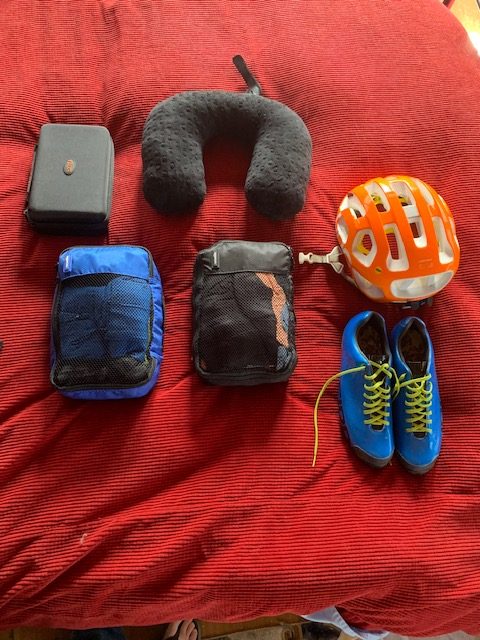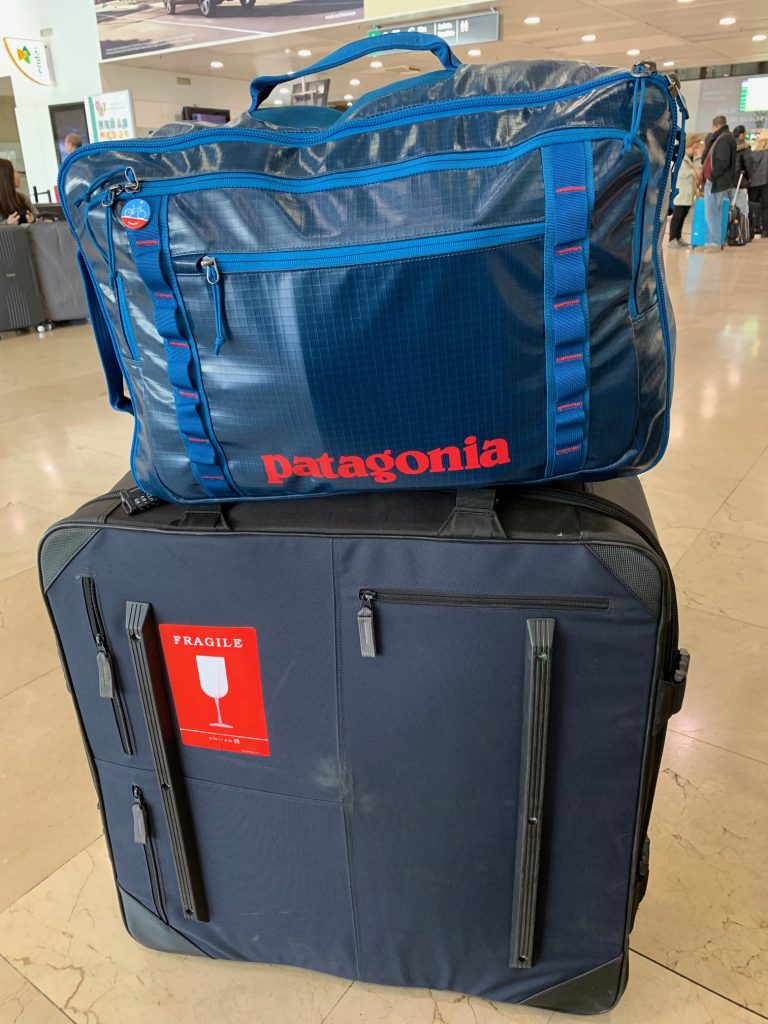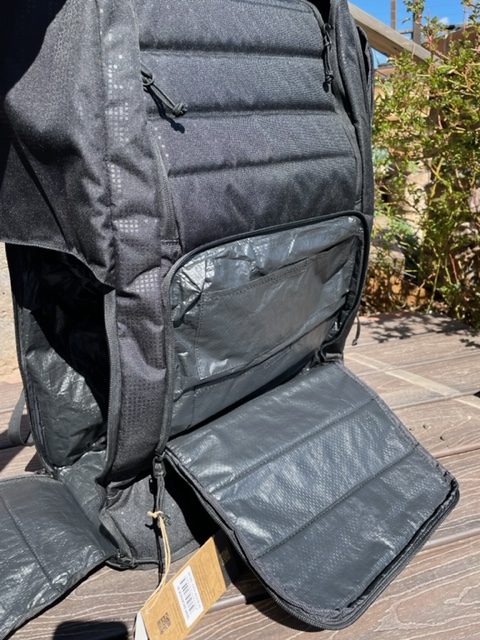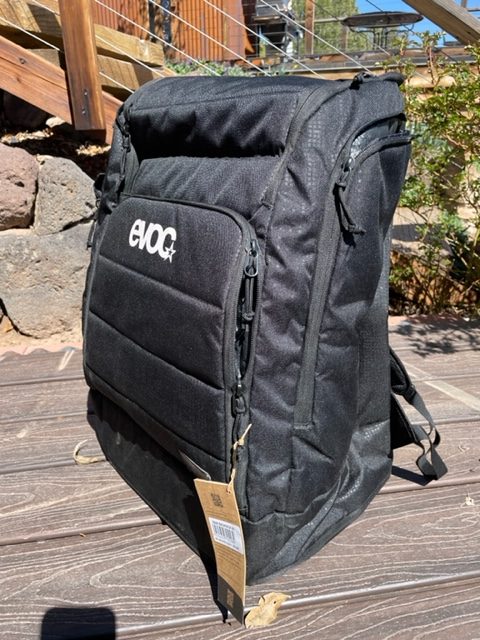Travel is coming back at a frightening speed, and airports are going to be crazy for 2022. Prices are skyrocketing, hotels are filling up, and long bike rides in distant lands are calling. Regular readers of this blog (there are 2; thanks guys) know that I like to travel with my bike, and that I hold very crusty and grumpy opinions about how to do it efficiently.
My occasional occupation as a suitcase redistribution engineer for a regional airline has let me see first-hand how different types and brands of suitcases move through the airline system. I’ve seen $1,000 suitcases shoot down loading belts in snow and rain faster than an Olympic luge, I’ve seen expensive soft-sided luggage explode at the zippers, spilling personal effects all over the cargo pit, and I’ve seen sports equipment (mostly snowboards) travel au natural, with only a luggage tag to protect them. Look, I get that traveling is expensive, but at least put your gear in an actual container of some kind.
After a couple of years of this experience, I bought Patagonia Black Hole bags for myself and my family. Duffles, shoulder bags, backpacks- it doesn’t matter. The fabric is bombproof, sticks to loading belts, the bags are designed to protect shoulder straps, and basically, they are the best bag on the market. Not only did I buy them, but nearly all of my 250+ co-workers will tell you that they own Black Holes as well. They’ve been my go-to bags for all travel, but despite how good they are, there are a few small issues that make them not-quite perfect for my needs. I own a good sampling of them, from small ultralight duffles to rollaboards to packs, all in multiple sizes. Each is sort of tailored to the travel plan at hand.
I’ve covered bike cases and transportation on other posts, this is not a re-hash of that. Having covered the bike case, it’s time to re-address the other stuff: kit, clothes, electronics, and how to carry that. I’ve used both the Patagonia Black Hole duffle and MLC, and both worked well, but not quite well enough for bike travel.
The Black Hole has amazing fabric, is very durable, and eats volumes of stuff. I have 2 duffles of different generations, one labeled 55 liters, and one labled 60. Oddly, the 55 is slightly larger. I also have the MLC (Maximum Legal Carryon) and mini MLC, both of which are great, but are smaller at 45 liters and 26, respectively. These are more of a messenger bag, with computer-oriented pockets and shoulder straps. I love all of these bags and use them for different types of trips, because yes, sometimes I don’t take my bike.
The large cavity offered by the Black Hole works well, but I have never been super happy with the way my 2 packing cubes of clothes and kit fit in with my helmet and shoes, plus electronics kit, bathroom kit, and other stuff that gets added at the last minute.




The upshot is that just reading the published volume and its actual dimensions don’t necessarily translate to whether something is the ideal travel bag. I have sketched out ideas for what I want a bag to do, but haven’t gotten past the sketch – I’m just not that kind of designer. I don’t know about how fabrics work together, let alone how to sew something up. And, from experience, I know to never ask Mrs. Mamil to sew something up for me on one of her two sewing machines- she hates my projects.
So, as is often the case, I went online and did research. EVOC is well known in the cycling world for their soft-sided bike travel bags. Although I have never owned one or gotten my grubby paws on one to play with, I have loaded plenty of them into a regional jet. I figured if they made bike bags, they might make other bags that pair well. Enter the Gear Backpack.
This pack is made in 2 sizes, 60 and 90 liters, and appears to be pretty new, because there is basically no information on Teh Interwebz about it. It’s priced reasonably at $125/145, and seems to be pretty cavernous. Their website shows pictures of both packs with skiboots and gear stuffed into the side pockets, as well as cycling gear. The larger version is dimensioned on the site, but not the smaller. I compared the 90 to my Black Hole, and the dimensions seemed pretty close to one another, so I ordered one up.
When it arrived, I was surprised at how large it actually is. I think I could easily put it in the overhead of a widebody, but there’s no way it’s going onboard with me as a carryon on a regional jet.
Also, the EVOC website really doesn’t do credit to the design, this bag has several well thought out aspects, as well as a couple of missed opportunities. The side load pocket is indeed huge, and can swallow 2 Scicon Rain Bags easily, with room for shoes and other stuff. The inner lining is a plasticy material, presumably waterproof, and it feels like the same fabric plastic tarps are made from. If it’s the same stuff, it’s pretty durable, but can be cut.

The top access of the pack has a flat divider which is held in place with Velcro. You can pull this open, then reach inside and push the liner of the side pocket over, making for a massive top-load pack.

I like the configurable nature of this design, it allows quite a lot of flexibility.
On one side of the pack is a flat pocket with a couple of anchoring loops. It’s farily wide and would fit a small to mid-size tablet pretty well. I think it’s meant for tools (their site shows screwdrivers), but the TSA would quickly add those to their collection of goodies if you tried to go through security with them. 
On the back is a large flap that opens up, with two smaller pockets that close with small patches of Velcro. This is probably good for TSA-friendly items, like gummy worms.

The top pocket, when set with its divider flap in place, is surprisingly large.

Based on the size of this pack, I think I could pack for 2 people for bike travel for a week. Even though EVOC and Scicon are direct competitors, EVOC designed a bag that holds the Scicon Rain Bag nearly perfectly (and inside a pack that costs considerably less than the Scicon bag). I’m really torn as to keeping the larger pack, because it is just large enough it will end up getting gate checked, which brings me to the design flaw that I found: there’s no way to remove or stash the shoulder and waist straps. As has been discussed elsewhere, ramp agents are not the cause of most bag damage, conveyor belts are. Since these straps stay exposed, they are prone to being caught and damaging the pack.
So, I ordered up the smaller 60L pack to see how much smaller it really is. EVOC does not publish the dimensions of this pack on their site, but now that I’ve held one and measured it, it’s the same footprint of the 90 (15.7″ x 10.6″ published, I measured more like 15″x 12″) and is 21″ tall vs 27″.
The pocket designs are the same, the top is simply smaller.

I placed my Scicon bag inside, with my shoes and 2 packing cubes that I like to use. In fact, I have not traveled with the rain bag, instead I use it as a day bag when heading out for rides. However, it will hold 2 sets of bibs, 2 jerseys, socks, jacket, vest, gloves, leg & arm warmers, sunglasses, and other goodies quite well. I typically take 3 ride kits and put them into a small cube, but may change this up slightly and make more use of the Scicon. I use the same size cube for 3 day’s worth of clothes. I bring a small case with a 6-port charger, my bike computer, batteries, etc, and a neck pillow for when I fly in Economy Minus.

Based on this mockup, the electronics kit fits very well in the top, and there is lots of room for the pillow and a light jacket. My tablet can fit into either the side or front pocket, and I think the bag won’t be overstuffed.

The 60 is a very manageable size, and probably won’t get checked (although it will end up on the carryon cart for a regional jet such as a CRJ-200, 700, or ERJ-175). Even if that happens, it would not go on a conveyor.
I’m certainly not getting rid of my Black Hole bags, the larger duffle carries a Feedback Sports Onmium trainer plus plenty of other kit very well, which is very important for my son when he travels to his races. I think that it simply means that my collection of bags is becoming more specialized for exactly the travel at hand.
EVOC has done a very good job with this pack, but their website really fails to show how well-designed it is. The switchable nature of the interior pocket is very clever and adds to the versatility of this pack. The fabric is a light pack fabric, not as beefy as a heavy Cordura or the Black Hole style rubberized fabric, but I think for a pack like this it’s suitable. This isn’t a technical pack for being worn on the trail, but I see it as a good door-to-door travel pack, one that stays at the hotel or in the car while you go play.
Overall, I am very impressed, and the only downside to it I see is the relatively skinny pads on the shoulder straps and the lack of a way to tuck them away when checking the pack. Patagonia has done excellent designs for this aspect on multiple bags, and perhaps its spoiled me, but as I said above, I can be grumpy and fussy. Or, maybe I’ve just seen lots of bag straps get caught in conveyor belts, and I don’t want to have it happen to mine.
So, will it supplant the Black Hole 55 or 60? Maybe. I like how stuff stacks in it, and I like how my rain bag slots in like a module. It may be that it distributes the volume better than the Patagonia stuff, but I won’t fully know until I pack up an go somewhere. In the short run, the EVOC bag performed very well on a car-camping trip at an 18-Hour mountain bike race, and I think it holds great promise. Since that quick weekend, I used the rain bag inside a Black Hole 25 liter pack, and it did fairly well for a 2-day trip, but it was not realistic for a 3-day trip, just not enough volume in the pack. The upshot is that I think the EVOC will find a niche for 7-day cycling trips, but not for 3-day non-cycling trips. In essence, it will join other bags and be used for specific applications, but I think it will be better than the Black Holes for how I like to travel with my bike.
Update, July 2022: I’ve done my first trip with the EVOC 60 liter pack (I returned the 90), using my rain bag and Tailfin Aeropack. I was able to put both in the lower section of the pack and then use the upper divider on top of them. The space on top was ample, with plenty of room for travel pillow, bathroom bag, electronics kit,etc. It was valet-checked on a regional flight, then fit easily in the overhead bin on my long-haul. I had to remove the legs of the Tailfin, but that was minor, and they fit nicely in my bike case.
Carrying the pack through large airports, buses, and trains was easy as it was well-balanced, and the shoulder straps had plenty of padding for the approximately 25-pound load. I found them to be more comfortable than the shoulder straps on the Patagonia 60 liter duffle for similar portages. At 60 liters, it’s not compact when fully loaded, but it doesn’t feel cumbersome, and it does an excellent job of carrying my particular combination of insert bags.
